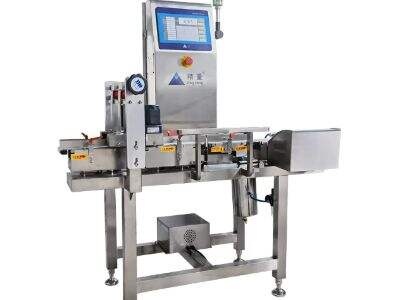Lorsqu'il s'agit de peser des produits dans les usines, il existe deux grandes catégories de machines : les contrôleurs de poids, dynamiques et statiques. Comprendre leurs différences est essentiel pour des entreprises comme Jing Liang lorsqu'elles décident d'acquérir l'une ou l'autre des solutions.
Les contrôleurs de poids capables de peser des objets pendant qu'ils se déplacent sur un tapis roulant sont appelés des contrôleurs de poids dynamiques.
Cela signifie que les produits n'ont pas besoin de s'arrêter pour être pesés, ce qui permet un mouvement fluide et rapide. Les contrôleurs de poids statiques sont des machines restant immobiles, c'est-à-dire que le produit est placé sur une plateforme de pesée.
Dans les usines, les contrôleurs de poids dynamiques offrent divers avantages.
Ils peuvent peser rapidement et avec précision les produits dès qu'ils sortent de la chaîne de production. Cela permet également de s'assurer que le produit a le poids correct et réduit le risque de sous-poids ou de surpoids, ce qui peut entraîner des problèmes tels que des rappels ou des amendes. Les contrôleurs dynamiques de poids peuvent également s'intégrer à d'autres machines, telles que les détecteurs de métaux, pour des contrôles qualité.
Cependant, les contrôleurs dynamiques de poids présentent certains inconvénients.
Ils sont généralement plus coûteux que les contrôleurs statiques de poids et nécessitent davantage d'entretien puisqu'ils comportent des pièces mobiles. De plus, ils ne conviennent peut-être pas aux produits les plus volumineux ou les plus lourds transportés.
Les contrôleurs statiques de poids constituent un moyen idéal de vérifier le poids des produits dans une usine sans investir trop d'argent.
Ces machines sont généralement moins onéreuses à l'achat que les contrôleurs dynamiques de poids et peuvent être conçues pour s'intégrer à une chaîne de production existante sans occuper trop d'espace au sol. Statique Balance-peseuse convient à une large gamme de tailles et de poids de produits.
Bien qu'ils ne soient pas aussi rapides que les contrôleurs de poids dynamiques, les modèles statiques mesurent néanmoins avec précision le poids des produits.
C'est ainsi que des entreprises comme Jing Liang peuvent respecter les règles et maintenir une haute qualité. Statique balance pesante sont également faciles à utiliser et nécessitent une formation limitée pour les employés.
Cependant, si l'on examine la précision des contrôleurs de poids, les deux catégories peuvent en réalité fournir des mesures précises, à condition d'être bien entretenues.
Les contrôleurs de poids dynamiques pourraient être légèrement plus précis, car ils pèsent en permanence. Les contrôleurs de poids statiques peuvent nécessiter un étalonnage fréquent pour garantir leur précision.
Ainsi, les entreprises, comme Jing Liang, devraient privilégier peseur dynamique ou les contrôleurs de poids statiques doivent réfléchir à leur niveau de production, à leur budget et à l'espace dont ils disposent. Il est également important de considérer le type de produits qu'elles pèsent, ainsi que le niveau de précision requis, par exemple pour des contrôles de qualité.
Table des Matières
- Les contrôleurs de poids capables de peser des objets pendant qu'ils se déplacent sur un tapis roulant sont appelés des contrôleurs de poids dynamiques.
- Dans les usines, les contrôleurs de poids dynamiques offrent divers avantages.
- Cependant, les contrôleurs dynamiques de poids présentent certains inconvénients.
- Les contrôleurs statiques de poids constituent un moyen idéal de vérifier le poids des produits dans une usine sans investir trop d'argent.
- Bien qu'ils ne soient pas aussi rapides que les contrôleurs de poids dynamiques, les modèles statiques mesurent néanmoins avec précision le poids des produits.
- Cependant, si l'on examine la précision des contrôleurs de poids, les deux catégories peuvent en réalité fournir des mesures précises, à condition d'être bien entretenues.

